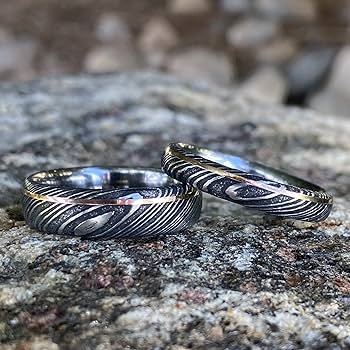Damascus wedding rings: Origins of damascus steel

Damascus steel is believed to have originated in India, where it was first produced as Wootz steel. Later, the steel was brought to the Middle East, refined and developed by Persian and Arab blacksmiths. The name “Damascus wedding rings” probably comes from the fact that it was widely traded in the Syrian city of Damascus.
IMPORTANCE OF DAMASCUS STEEL IN HISTORICAL PERIODS
Damascus steel was highly prized in various historical periods, such as the Crusades and the Islamic Golden Age. It was used to create weapons, such as swords, daggers, axes, armor and other tools.
The strength, sharpness and beauty of Damascus steel made it a status symbol among nobles and warriors alike.
How Damascus steel is manufactured
The Damascus steel manufacturing process is complex and involves several steps. Below, we discuss the traditional Damascus steelmaking process and the modern techniques that have been developed.
TRADITIONAL DAMASCUS STEELMAKING METHOD
The traditional method of making Damascus wedding rings involves combining two or more types of steel with different carbon contents. You can weld either a bundle of strips or a bundle of interlocking steel bars of various grades of steel together. The steel is then heated until it is malleable and can be forged into a bar or billet.
The billet is then bent and hammered repeatedly to create layers of steel. The layers are welded together, often with flux material added to prevent rusting. This process is repeated several times until multiple layers are obtained.
As a result of this process, a rather chaotic mixture of metal layers is produced and, as a result, a non-uniform random pattern is formed. Depending on the number of layers, the grades of steel used and the thickness of the workpieces, its pattern can be the most diverse.
MODERN METHOD OF MAKING STEEL DAMASCUS
Modern methods of making Damascus include the fabrication of Mosaic Damascus. Damascus mosaic steel is manufactured by several methods. One of which is the preparation of a large number of contrasting mosaic elements placed inside a metal container (most often a metal pipe).
After placing all the components of the future Damascus billet inside the pipe, it is filled with powdered steel around them to lock the components in place and welded completely. The pipe is then heated in the forge to welding temperature and forged.
After the Damascus billet inside the metal pipe is welded, the pipe is mechanically removed and the billet inside is processed further. Another way to form a mosaic pattern is an even more technologically advanced method of processing the Damascus wedding rings.
It involves cutting a series of holes in a steel bar with a plasma cutter, representing a future pattern, into which inserts are then placed, also cut by a plasma cutter, but of a different grade of steel (or alloy). Then, the resulting workpiece is welded by the diffusion method in an inert gas environment.

Damascus steel is believed to have originated in India, where it was first produced as Wootz steel. Later, the steel was brought to the Middle East, refined and developed by Persian and Arab blacksmiths. The name “Damascus wedding rings” probably comes from the fact that it was widely traded in the Syrian city of Damascus.
IMPORTANCE OF DAMASCUS STEEL IN HISTORICAL PERIODS
Damascus steel was highly prized in various historical periods, such as the Crusades and the Islamic Golden Age. It was used to create weapons, such as swords, daggers, axes, armor and other tools.
The strength, sharpness and beauty of Damascus steel made it a status symbol among nobles and warriors alike.
How Damascus steel is manufactured
The Damascus steel manufacturing process is complex and involves several steps. Below, we discuss the traditional Damascus steelmaking process and the modern techniques that have been developed.
TRADITIONAL DAMASCUS STEELMAKING METHOD
The traditional method of making Damascus wedding rings involves combining two or more types of steel with different carbon contents. You can weld either a bundle of strips or a bundle of interlocking steel bars of various grades of steel together. The steel is then heated until it is malleable and can be forged into a bar or billet.
The billet is then bent and hammered repeatedly to create layers of steel. The layers are welded together, often with flux material added to prevent rusting. This process is repeated several times until multiple layers are obtained.
As a result of this process, a rather chaotic mixture of metal layers is produced and, as a result, a non-uniform random pattern is formed. Depending on the number of layers, the grades of steel used and the thickness of the workpieces, its pattern can be the most diverse.
MODERN METHOD OF MAKING STEEL DAMASCUS
Modern methods of making Damascus include the fabrication of Mosaic Damascus. Damascus mosaic steel is manufactured by several methods. One of which is the preparation of a large number of contrasting mosaic elements placed inside a metal container (most often a metal pipe).
After placing all the components of the future Damascus billet inside the pipe, it is filled with powdered steel around them to lock the components in place and welded completely. The pipe is then heated in the forge to welding temperature and forged.
After the Damascus billet inside the metal pipe is welded, the pipe is mechanically removed and the billet inside is processed further. Another way to form a mosaic pattern is an even more technologically advanced method of processing the Damascus wedding rings.
It involves cutting a series of holes in a steel bar with a plasma cutter, representing a future pattern, into which inserts are then placed, also cut by a plasma cutter, but of a different grade of steel (or alloy). Then, the resulting workpiece is welded by the diffusion method in an inert gas environment.